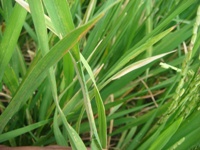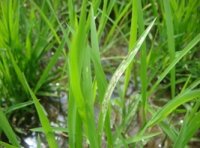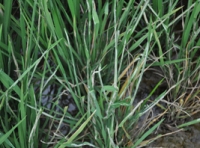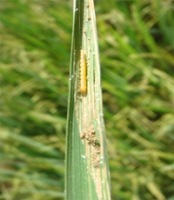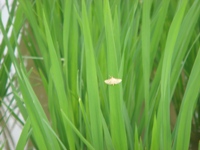| Management Strategies: |
|
Cultural Methods:
- Use resistant varieties like, Cauveri, Akashi, TKM 6, TKM 12, ADT 46,TPS 2, TPS 3, ADT 44, PY 4, Kairali,Ahalya,kunju kunju varna, kunju kunju priya, Reshmi (PTB 44), Neeraja(PTB 47) and Deepthi.
- Keep the bunds clean by trimming them and remove the grassy weeds.
- Avoid use of excessive nitrogenous fertilizers.
- Avoid use of carbofuran (or) phorate granules to control resurgence of pests.
- Clipping of the affected leaves.
- Use of rope to dislodge the leaf feeding larvae of leaf folders.
- Open up the leaf folds with the help of a thorny twig.
|
 |
 |
| Avoid Use of Phorate Granules |
Keep the bunds clean |
 |
 |
| Use resistant varieties ADT 46 |
Use resistant varieties TPS3 |
|
Chemical Methods:
- ETL : 10% leaf damage at vegetative phase and 5% of flag leaf damage at flowering.
- The population should be estimated on the basis of careful and regular surveillance.
- When natural enemies of leaf folders are present, application of chemical measures can be delayed or dispensed with.
- In the initial stages restrict spraying to infested patches only. The field may be sprayed completely in case the infestation occurs uniformly.
- Spray any one of the following based on ETLs :
Fenitrothion 50 EC 1000 ml/ha (or) Phosalone 35 EC 1500 ml/ha (or) Quinalphos 25 EC 1000 ml/ha (or) Dichlorvos 76 WSC 250 ml/ha (or) Phosphamidon 40 SL 600 ml/ha (or) Chlorpyriphos 20 EC 1250 ml/ha (or) Carbaryl 50 WP 1.0 kg/ha (or) Fenthion 100 EC 500 ml/ha (or) Profenophos 50 EC 1000 ml/ha.
|
 |
 |
| Spray Chlorpyriphos |
Spray Phosphamidon |
 |
 |
| Spray Quinalphos |
Spraying of Insecticide |
|
Biological Methods:
- Release Trichogramma chilonis (Egg Parasitoids) thrice on 37, 44 and 51 DAT @ 5 cc(1 lakh egg parasitoids)/ha/release.
- Release the egg cards in field during morning hours.
- Tie the egg cards under the leaf surface facing outside.
- Avoid spraying of chemicals three days before and upto seven days after field release of egg cards.
|
 |
 |
| Trichogramma chilonis |
Field release of Trichogramma |
|
Natural enemies and predators:
Natural enemies :
- Itoplectis narangae - Ichnuemonidae Wasp
- Trichomma cnaphalocrocis - Ichnuemonidae Wasp
Predators :
- Release of mirid bug Cytorhinus lividipennis @ 50 – 75 egg/ m2
|
 |
 |
| Natural Enemy - Trichomma cnaphalocrocis |
Predator - Micraspis crocea |
|
Trap Methods:
- Set up light traps to attract and kill the moths. Set up light trap one for at least 5 ha.
- Set up bird perches (40 to 50/ha) of Insectivorous Birds at vegetative phase of crop.
- Monitor through phermone traps (@ 10 to 12/ha for timely control measures. Change the lure at 15-20 days intervals.
|
 |
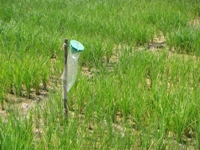 |
| Set up light trap |
Use pheromone traps |
| Top |
